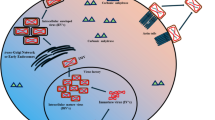Summary
Recombinant vaccinia virus (RVV) containing the full-length cDNA of rinderpest virus (RV)-haemagglutinin (H) gene was constructed. The H gene was inserted into the attenuated vaccine strain of vaccinia virus (VV), Lc 16 m0, with two different promoters, namely cowpox virus A-type inclusion body (ATI) promoter or VV 7.5 kilodalton (P7.5) promoter. These RVVs produced the same sized fully glycosylated RV-H protein in RK 13 cells as that of the authentic RV-H. Their heat stability in the lyophylized state was similar to that of the parental VV. All rabbits immunized with these RVVs produced virus neutralizing (VN) antibody to RV as well as anti RV-H antibody. Four weeks after immunization, these animals were challenged with RV intravenously. None of the RVV-immunized rabbits developed any clinical signs of RV infection except one which was immunized with RVV containing the ATI promoter and developed low VN titer. These results indicate the possibility of developing a heat-stable recombinant vaccine for the eradication of rinderpest in tropical countries without cold storage systems.
Similar content being viewed by others
References
Cheneau Y (1985) Prevalence of rinderpest and strategy of the Pan-African Campaign. Rev Sci Tech Off Int Epizool 4: 415–425
Fukuda A, Yamanouchi K (1976) Autoimmunity induced in rabbits by rinderpest virus. Infect Immun 13: 1449–1453
Funahashi S, Sato T, Shida H (1988) Cloning and characterization of the gene encoding the major protein of cowpox virus. J Gen Virol 69: 35–47
Giraudon P, Wild TF (1985) Correlation between epitopes on hemagglutinin of measles virus and biological activities: passive protection by monoclonal antibodies is related to their hemagglutination inhibiting activity. Virology 144: 46–58
Hashizume S, Yoshizawa H, Morita M, Suzuki K (1985) Properties of attenuated mutant vaccinia virus, Lc 16 m 8, derived from Lister strain. In: Quinnan GV Jr (ed) Vaccinia viruses as vector for vaccine antigens. Elsevier, New York, p 87–99
Imaoka K, Kanai Y, Nishizawa Y, Yoshikawa Y, Yamanouchi K (1988) Induction of antinuclear antibodies in rabbits by infection with rinderpest viruses with different degree of virulence. Jpn J Vet Sci 50: 1115–1118
Ishii H, Yoshikawa Y, Yamanouchi K (1986) Adaptation of the lapinized rinderpest virus in vitro growth and attenuation of its virulence in rabbits. J Gen Virol 67: 275–280
Languet B, Precausta P, Mackowiak M, Dubourget P, Reynaud G, Duret C (1985) Freeze-dried vaccine against rinderpest: stability and activity study. Comp Immunol Microbiol Infect Dis 8: 285–295
Mackett M, Smith GL (1986) Vaccinia virus expression vectors. J Gen Virol 67: 2067–2082
Memorandum from a WHO/USPHS/NIBSC Meeting (1985) Recombinant vaccinia viruses as live virus vectors for vaccine antigens. Bull WHO 63: 471–477
Nakamura J, Miyamoto T (1953) Avianization of lapinized rinderpest virus. Am J Vet Res 14: 307–317
Shida H (1986) Nucleotide sequence of the vaccinia virus hemagglutinin gene. Virology 150: 451–462
Tsukiyama K, Sugiyama M, Yoshikawa Y, Yamanouchi K (1987) Molecular cloning and sequence analysis of the rinderpest virus mRNA encoding the hemagglutinin protein. Virology 160: 48–54
Weir JP, Bajszar G, Rott R (1982) Mapping of the vaccinia virus thymidine kinase gene by marker rescue and by cell-free translation of selected mRNA. Proc Natl Acad Sci USA 79: 1210–1214
Yamanouchi K, Chino F, Kobune F, Fukuda H, Yoshikawa Y (1974) Pathogenesis of rinderpest infection in rabbits. I. Clinical signs, immune response, histological changes and virus growth patterns. Infect Immun 9: 199–205
Yamanouchi K, Fukuda A, Kobune F, Yoshikawa Y, Chino F (1974) Pathogenesis of rinderpest virus infection in rabbits. II. Effect of rinderpest virus on the immune functions of rabbits. Infect Immun 9: 206–211
Yilma T, Hsu D, Jones L, Owens S, Grubman M, Mebus C, Yamanaka M, Dale B (1988) Protection of cattle against rinderpest with vaccinia virus recombinants expressing the HA or F gene. Science 242: 1058–1061
Yoshikawa Y, Yamanouchi K, Morikawa Y, Sakaguchi M (1983) Characterization of canine distemper viruses adapted to neural cells and their neurovirulence in mice. Microbiol Immunol 27:503–518
Author information
Authors and Affiliations
Rights and permissions
About this article
Cite this article
Tsukiyama, K., Yoshikawa, Y., Kamata, H. et al. Development of heat-stable recombinant rinderpest vaccine. Archives of Virology 107, 225–235 (1989). https://doi.org/10.1007/BF01317919
Received:
Accepted:
Issue Date:
DOI: https://doi.org/10.1007/BF01317919




